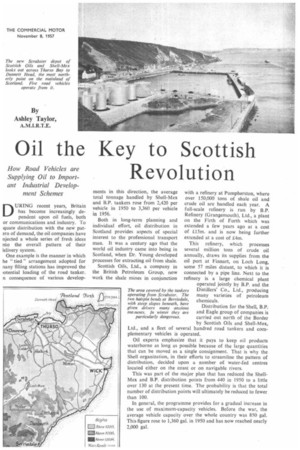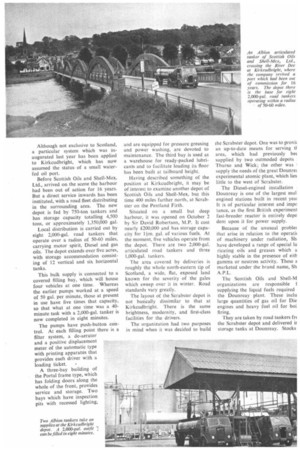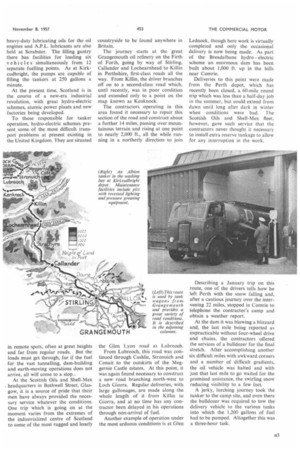Oil the Key to Scottish Revolution
Page 119

Page 120

Page 121

If you've noticed an error in this article please click here to report it so we can fix it.
How Road Vehicles are Supplying Oil to Important Industrial Development Schemes
DURING recent years, Britain has become increasingly dependent upon oil fuels, both or communications and industry. To quate distribution with the new patern of demand, the oil companies have njected a whole series of fresh ideas nto the overall pattern of their lelivery system.
One example is the manner in which he " tied " arrangement adopted for nany filling stations has improved the lotential loading of the road tanker. n consequence of various develop ments in this direction, the average total tonnage handled by Shell-Mex and B.P. tankers rose from 2,420 per vehicle in 1950 to 3,360 per vehicle in 1956.
Both in long-term planning and individual effort, oil distribution in Scotland provides aspects of special interest to the professional transport man. It was a century ago that the world oil industry came into being in Scotland, when Dr. Young developed processes for extracting oil from shale.
Scottish Oils, Ltd., a company in the British Petroleum Group, now work the shale mines in conjunction with a refinery at Pumpherston, where over 150,000 tons of shale oil and crude oil are handled each year. A full-scale refinery is run by B.P. Refinery (Grangemouth), Ltd., a plant on the Firth of Forth which was extended a few years ago at a cost of £15m. and is now being further extended at a cost of £4m.
This refinery, which processes several million tons of crude oil annually, draws its supplies from the oil port at Finnart, on Loch Long, some 57 miles distant, to which it is connected by a pipe line. Next to the refinery is a large chemical plant operated jointly by B.P. and the Distillers' Co., Ltd., producing many varieties of petroleum chemicals.
Distribution for the Shell, B.P. and Eagle group of companies is carried out north of the Border by Scottish Oils and Shell-Mex, Ltd., and a fleet of several hundred road tankers and complementary vehicles is operated.
Oil experts emphasize that it pays to keep oil products waterborne as long as possible because of the large quantities that can be moved as a single consignment. That is why the Shell organization, in their efforts to streamline the pattern of distribution, decided upon a number of water-fed centres located either on the coast or on navigable rivers.
This was part of the major plan that has reduced the ShellMex and B.P. distribution points from 440 in 1950 to a little over 130 at the present time. The probability is that the total number of distribution points will ultimately be reduced to fewer than 100.
In general, the programme provides for a gradual increase in the use of maximum-capacity vehicles. Before the war, the average vehicle capacity over the whole country was 850 gal. This figure rose to 1,360 gal. in 1950 and has now reached nearly 2,000 gal.
particularly dangerous.
Although not exclusive to Scotland, a particular system which was inaugurated last year has been applied to Kirkcudbright, which has now assumed the status of a small water fed oil port.
Before Scottish Oils and Shell-Mex.
Ltd., arrived on the scene the harbour had been out of action for 16 years. But a direct service inwards has been instituted, with a road fleet distributing in the surrounding area. The new depot is fed by 750-ton tankers and has storage capacity totalling 4,500 tons, or approximately 1,350,000 gal.
Local distribution is carried out by eight 2,000-gal road tankers that operate over a radius of 50-60 miles, carrying motor spirit, Diesel and gas oils. The depot extends over five acres, with storage accommodation consisting of 12 vertical and six horizontal tanks.
This bulk supply is connected to a covered filling bay, which will house four vehicles at one time. Whereas the earlier pumps worked at a speed of 50 gal. per minute, those at present in use have five times that capacity, so that what at one time was a 40minute task with a 2,000-gal. tanker is now completed in eight minutes.
The pumps have push-button control. At each filling point there is a filter system, a de-aerator and a positive displacement meter of the automatic type with printing apparatus that provides each driver with a loading ticket. • A three-bay building of the Portal frame type, which has folding doors along the whole of the front, provides service and storage. Two bays which have inspection pits with recessed lighting, and are equipped for pressure greasing and power washing, are devoted to maintenance. The third bay is used as a warehouse for ready-packed lubricants and to facilitate loading its floor has been built at tailboard height.
Having described something of the position at Kirkcudbright, it may be of interest to examine another depot of Scottish Oils and Shell-Mex, but this time 400 miles farther north, at Scrabster on the Pentland Firth.
Situated on a small but deep harbour, it was opened on October 2 by Sir David Robertson, M.P. It cost nearly £200,000 and has storage capacity for 14m. gal. of various fuels. At the moment, five vehicles operate from the depot. There are two 2,000-gal. articulated road tankers and three 1,000-gal. tankers.
The area covered by deliveries is roughly the whole north-eastern tip of Scotland, a wide, flat, exposed land known for the severity of the gales which sweep over it in winter. Road standards vary greatly.
The layout of the Scrabster depot is not basically dissimilar to that at Kirkcudbright. There is the same brightness, modernity, and first-class facilities for the drivers.
The organization had two purposes in mind when it was decided to build the Scrabster depot. One was to provic an up-to-date means for serving If area, which had previously be supplied by two outmoded depots Thurso and Wick; the other was I supply the needs of the great Dounrer experimental atomic plant, which lies little to the west of Scrabster.
The Diesel-engined installation Dounreay is one of the largest mull engined stations built in recent yea' It is of particular interest and impo tance, as the first British experiment fast-breeder reactor is entirely depe dent upon it for power supply.
Because of the unusual probler that arise in relation to the operatic of machinery under radiation, Shi have developed a range of special lu ricating oils and greases which a highly stable in the presence of eith gamma or neutron activity. These a marketed under the brand name, Sh A.P.L.
The Scottish Oils and Shell-M organizations are responsible supplying the liquid fuels required the Dounreay plant. These inclu large quantities of gas oil for Die: engines and heavy fuel oil for boi firing.
They are taken by road tankers frc the Scrabster depot and delivered ir storage tanks at Dounreay. Stocks
heavy-duty lubricating oils for the oil engines and A.P.L. lubricants are also held at Scrabster. The filling gantry there has facilities for loading six vehicles simultaneously from 12 separate fuelling points. As at Kirkcudbright, the pumps arc capable of filling the tankers at 250 gallons a minute.
At the present time, Scotland is in the course of a new-era industrial revolution, with great hydro-electric schemes, atomic power plants and new factories being developed.
To those responsible for tanker operation, hydro-electric schemes present some of the most difficult transport problems at present existing in the United Kingdom. They are situated in remote spots, often at great heights and far from regular roads. But the loads must get through, for if the fuel for the vast tunnelling, dam-building and earth-moving operations does not arrive, all will come to a stop. ,
At the Scottish Oils and Shell-Mex headquarters in Bothwell Street, Glasgow, it is a source of pride that their men have always provided the necessary service whatever the conditions. One trip which is going on at the moment varies from the extremes of the industrialized centre of Scotland to some of the most rugged and lonely
countryside to be found anywhere in Britain.
The journey starts at the great Grangemouth oil refinery on the Firth of Forth, going by way of Stirling, Callender and Lochearnhead to Kuhn in Perthshire, first-class roads all the way. From Killin, the driver branches off on to a second-class road which, until recently, was in poor condition and extended only to a point on the map known as Kenknock.
The contractors operating in this area found it necessary to repair this section of the road and construct about a further 14 miles, passing over mountainous terrain and rising at one point to nearly 2,000 ft., all the while running in a northerly direction to join
the Glen Lyon road at Lubreoch.
From Lubreoch, this road was continued through Cashlie, Stronuich and Conait to the outskirts of the Meggernie Castle estates. At this point, it was again found necessary to construct a new road branching north-west to Loch Giorra. Regular deliveries, with large gallonages, are made along the whole length of it from Killin to Giorra, and at no time has any contractor been delayed in his operations through non-arrival of fuel.
Another example of operation under the most arduous conditions is at Glen Lednock, though here work is virtually completed and only the occasional delivery is now being made. As part of the Breadal bane hydro electric scheme an enormous darn has been built about 1,000 ft. up in the hills near Comrie.
Deliveries to this point were made from the Perth depot, which has recently been closed, a 60-mile round trip which was less than a half-day job in the summer, but could extend from dawn until long after dark in winter when conditions were bad. The Scottish Oils and Shell-Mex fleet, however, gave such service that the contractors never thought it necessary to install extra reserve tankage to allow for any interruption in the work.
Describing a January trip on this route, one of the drivers tells how he left Perth with the snow falling and, after a cautious journey over the intervening 22 miles, stopped in Comrie to telephone the contractor's camp and obtain a weather report.
At the dam it was blowing a blizzard and, the last mile being reported as impracticable without four-wheel drive and chains, the contractors offered the services of a bulldozer for the final stretch. After accomplishing another six difficult miles with awkward corners and a number of difficult gradients, the oil vehicle was halted and with just that last mile to go waited for the promised assistance, the swirling snow reducing visibility to a few feet.
A jerky, lurching journey took the tanker to the camp site, and even there the bulldozer was required to tow the delivery vehicle to the various tanks into which the 1,200 gallons of fuel had to be pumped. Altogether this was a three-hour task.




























































































































































































































































